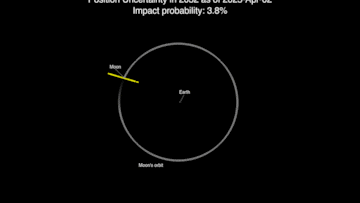An asteroid the size of a building could wreak havoc on the Moon, and now we’ve lost sight of it
A small shift in trajectory has raised the risk of a lunar impact — but the scariest part is, we can’t track it anymore.

An asteroid roughly the size of a high-rise building is on a new path toward the Moon — and Earth-based telescopes can no longer see it.
The object, known as 2024 YR4, was already on NASA’s radar after making headlines last year for a near pass by Earth. Back then, some feared it could collide with our planet, but those concerns were ruled out. Now, however, the attention has turned to a different target: the Moon.
Thanks to new readings from the James Webb Space Telescope, scientists have confirmed a subtle but important shift in the asteroid’s orbit. That change has raised the odds of a lunar impact from 3.8% to 4.3%, according to data cited by National Geographic.
That may not sound like much — but in space terms, it’s enough to matter.
Could this asteroid really hit the Moon?
The potential impact date is December 22, 2032, when 2024 YR4 is expected to pass extremely close to the Moon. At that point, astronomers hope to have a much clearer sense of its path.
But even in a worst-case scenario, experts say the Moon’s orbit would remain stable. While 2024 YR4 is big — estimated to be 130 to nearly 300 feet wide — it’s not large enough to destabilize the lunar system.
Still, a direct hit could leave a visible new crater, send dust flying, and become a scientific event of enormous interest.
🆕 Webb has turned its watchful eye on asteroid 2024 YR4 ☄️ which we now know poses no significant threat to Earth.
— ESA Webb Telescope (@ESA_Webb) April 3, 2025
Read more: https://t.co/FerEkDqJLx or 🧵👇 pic.twitter.com/oLjwNG6G0h
Why we can’t track it right now
Here’s the unsettling twist: we’ve lost visual contact with the asteroid.
NASA and international observatories currently can’t track 2024 YR4 with either ground-based or space telescopes. It has drifted too far into space to be seen.
The next chance scientists will have to analyze its trajectory is in 2028, when it comes back into range.
Until then, astronomers will rely on simulations and data modeling to monitor any further changes in its path.
Get your game on! Whether you’re into NFL touchdowns, NBA buzzer-beaters, world-class soccer goals, or MLB home runs, our app has it all.
Dive into live coverage, expert insights, breaking news, exclusive videos, and more – plus, stay updated on the latest in current affairs and entertainment. Download now for all-access coverage, right at your fingertips – anytime, anywhere.
Complete your personal details to comment